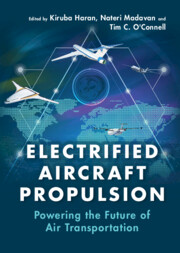Book contents
- Electrified Aircraft Propulsion
- Electrified Aircraft Propulsion
- Copyright page
- Dedication
- Contents
- Contributors
- Preface
- 1 Benefits of Electrified Propulsion for Large Aircraft
- 2 Aircraft Electric Power System Design, Control, and Protection
- 3 Megawatt-Scale Electric Machines for Electrified Aircraft Propulsion
- 4 Superconducting Machines and Cables
- 5 Conventional Power Electronics for Electrified Aircraft Propulsion
- 6 Cryogenic Power Electronics
- 7 Electrochemical Energy Storage and Conversion for Electrified Aircraft
- 8 Thermal Management of Electrified Propulsion Systems
- 9 Performance Assessment of Electrified Aircraft
- Index
- References
8 - Thermal Management of Electrified Propulsion Systems
Published online by Cambridge University Press: 11 May 2022
- Electrified Aircraft Propulsion
- Electrified Aircraft Propulsion
- Copyright page
- Dedication
- Contents
- Contributors
- Preface
- 1 Benefits of Electrified Propulsion for Large Aircraft
- 2 Aircraft Electric Power System Design, Control, and Protection
- 3 Megawatt-Scale Electric Machines for Electrified Aircraft Propulsion
- 4 Superconducting Machines and Cables
- 5 Conventional Power Electronics for Electrified Aircraft Propulsion
- 6 Cryogenic Power Electronics
- 7 Electrochemical Energy Storage and Conversion for Electrified Aircraft
- 8 Thermal Management of Electrified Propulsion Systems
- 9 Performance Assessment of Electrified Aircraft
- Index
- References
Summary
This chapter details the unique challenge of managing electric drivetrain (EDT) waste heat in electrified aircraft propulsion (EAP) architectures. Hybrid-fueled and hybrid-electric propulsion systems make up the hybrid propulsion family, and these are composed of various combinations of fueled-engine and battery-electric propulsion systems. All comprise EAP systems, and they are analyzed here to assess their thermal performance and thermal management (TM) impacts on the aircraft. An introduction to the TM of HEPS is followed by a discussion of EDT heat sources and aircraft heat sinks. Next follows a summary of TM challenges specific to EDTs and thermal management system (TMS) heat acquisition and component cooling approaches. A review of TMS architectures leads to a reference TMS that is used to introduce general analysis concepts and heat transport and rejection components, including the underlying physics-based equations necessary for their analysis. The chapter concludes with a detailed step-by-step design of the reference TMS, listing constraints, imposed conditions, calculated values, and free parameters.
Keywords
- Type
- Chapter
- Information
- Electrified Aircraft PropulsionPowering the Future of Air Transportation, pp. 224 - 255Publisher: Cambridge University PressPrint publication year: 2022



